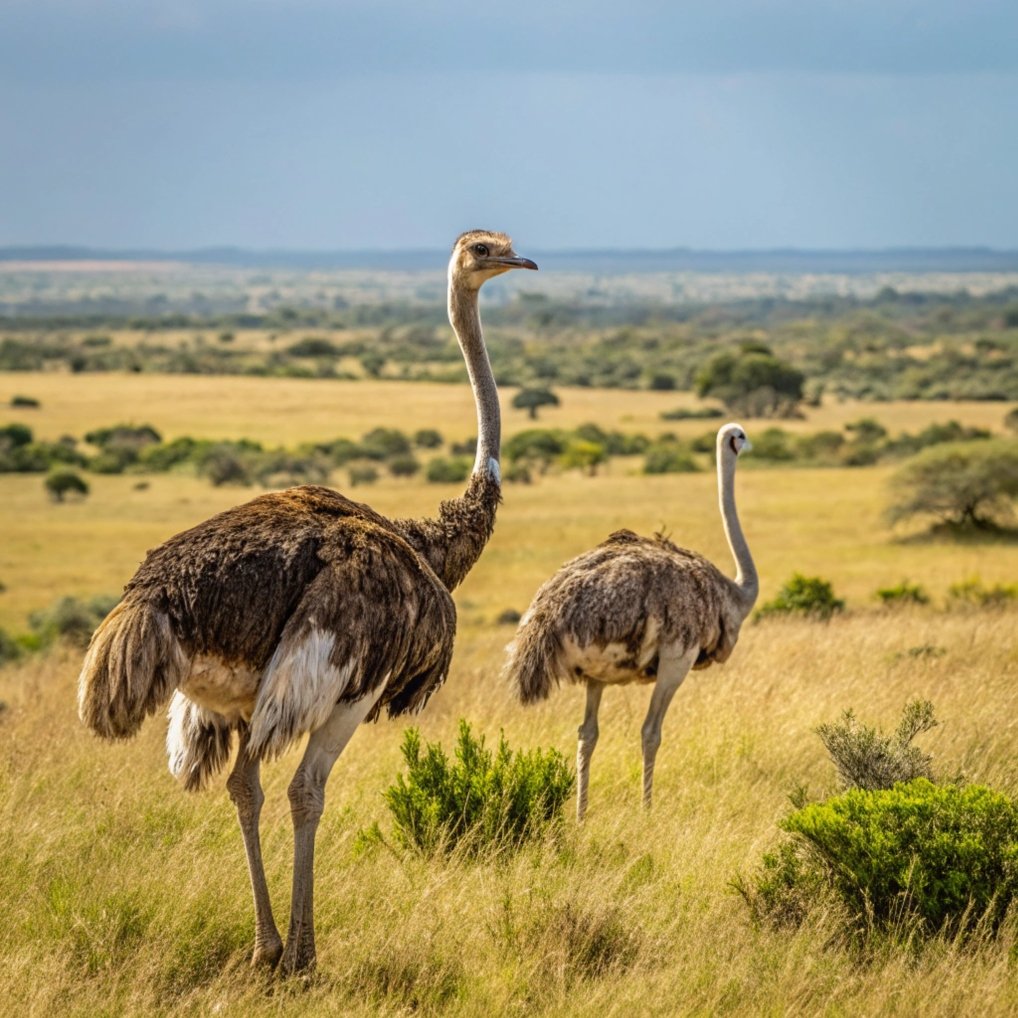Why Ostriches Hide Their Heads in Sand? – The Myth Debunked
Ostriches, the largest birds on Earth, have long been associated with the peculiar behavior of burying their heads in the sand when faced with danger.
This widely believed myth has persisted for centuries, leading to the popular phrase “bury your head in the sand” to describe someone avoiding reality or refusing to face problems.
However, this notion is entirely false and based on misunderstandings of ostrich behavior.

Key Takeaways
- Ostriches do not bury their heads in the sand when faced with danger.
- The myth originated from ancient Roman naturalist Pliny the Elder’s misinterpretation of ostrich behavior.
- Ostriches have keen eyesight and can run at speeds up to 43 miles per hour to evade predators.
- Nesting behaviors and foraging habits may have contributed to the misconception.
- Ostriches employ a unique “head down” defense mechanism when unable to escape danger.
- These birds have developed effective camouflage techniques to blend into their environment.
- Ostriches play a significant role in their ecosystems as large herbivores and seed dispersers.
- The persistence of this myth has influenced human language and behavior, spawning the idiom “burying one’s head in the sand.”
- Understanding the true nature of ostrich behavior is crucial for scientific accuracy, animal welfare, and conservation efforts.
- Ostriches possess remarkable adaptations, including speed, vision, and unique digestive systems, which are far more interesting than the mythical head-burying behavior.
The Origin of the Ostrich Head-Burying Myth
The belief that ostriches bury their heads in the sand can be traced back to ancient times. Roman naturalist Pliny the Elder, who lived around 2,000 years ago, is often credited with popularizing this misconception.
In his encyclopedic work “The Natural History,” Pliny described ostriches as having the “marvelous property” of believing themselves hidden when they thrust their heads into bushes.
This description, while inaccurate, laid the foundation for the enduring myth that has persisted through the ages.
The vivid image of an ostrich with its head buried in the sand captured the imagination of people, leading to its widespread acceptance and incorporation into popular culture.
Over time, this myth became so ingrained in human consciousness that it spawned the well-known idiom “to bury one’s head in the sand,” used to describe willful ignorance or refusal to acknowledge a problem.
The Reality of Ostrich Behavior

Contrary to popular belief, ostriches do not actually bury their heads in the sand. This myth is a complete misinterpretation of their natural behaviors.
In reality, ostriches are highly intelligent and adaptable birds with a range of survival strategies that have evolved over millions of years.
When faced with danger, ostriches rely on their keen eyesight and impressive speed to evade predators. These birds have eyes larger than their brains, allowing them to spot potential threats from great distances.
If an ostrich detects a predator, its first instinct is to run away, not to bury its head.
Ostriches are incredibly fast runners, capable of reaching speeds up to 43 miles per hour (70 km/h). This makes them the fastest birds on land and one of the fastest two-legged animals in the world.
Their powerful legs not only enable them to outrun many predators but can also deliver kicks strong enough to seriously injure or even kill large predators like lions.
Nesting Behaviors Mistaken for Head-Burying
One possible explanation for the head-burying myth stems from ostrich nesting behaviors.
Unlike many birds that build nests in trees or bushes, ostriches create their nests on the ground. The male ostrich digs a shallow hole in the sand or dirt to serve as a nest for the eggs.
During the nesting period, both male and female ostriches take turns incubating the eggs. They use their beaks to rotate the eggs several times a day, ensuring even heating.
From a distance, an ostrich leaning into the nest to turn its eggs might appear to have its head buried in the sand.
This behavior, when observed from afar or without proper context, could easily be misinterpreted as the bird burying its head.
However, this is simply a part of their natural nesting process and has nothing to do with hiding or avoiding danger.
Foraging Habits That Resemble Head-Burying

Another behavior that might contribute to the myth is the ostrich’s foraging habits. Ostriches are omnivores, primarily feeding on plants but occasionally consuming small animals like insects, lizards, or rodents.
When searching for food, ostriches often lower their heads close to the ground, using their keen eyesight to spot potential meals.
This posture, especially when viewed from a distance, could give the impression that the ostrich has its head buried in the sand.
In reality, the ostrich is simply scanning the ground for food, demonstrating its adaptability to its environment and its efficient foraging techniques.
This behavior is crucial for the ostrich’s survival in its natural habitat, which often includes arid regions with sparse vegetation.
The “Head Down” Defense Mechanism
While ostriches don’t bury their heads in the sand, they do have a unique defense mechanism that might have contributed to this myth.
When an ostrich senses danger and cannot escape, it may employ a strategy known as the “head down” or “head forward” posture.
In this position, the ostrich lowers its head and neck close to the ground, stretching them out horizontally.
From a distance, this might look as if the bird has buried its head. However, this posture serves a crucial purpose in the ostrich’s survival strategy.
By lowering its head, the ostrich can better observe its surroundings and detect potential threats. This position allows the bird to utilize its excellent eyesight and acute hearing to stay vigilant against predators or other dangers.
Camouflage Techniques of Ostriches
Ostriches have developed effective camouflage techniques that help them blend into their environment. When threatened and unable to flee, an ostrich may lie flat on the ground, extending its long neck along the surface.
This posture allows the ostrich to blend in with the surrounding terrain, making it difficult for predators to spot. The ostrich’s coloration, typically a mix of black, white, and brown feathers, further aids in this camouflage effect.
Some reports suggest that adult ostriches might use their wings to disturb the dust beneath them, creating a cloud to distract nearby predators away from their chicks.
This behavior, while not head-burying, demonstrates the ostrich’s resourcefulness in protecting itself and its offspring.
The Ostrich’s Impressive Physical Attributes
Understanding the ostrich’s physical attributes helps explain why the head-burying myth is so implausible.
Ostriches are the largest living birds, standing up to 9 feet (2.7 meters) tall and weighing as much as 350 pounds (159 kilograms).
Despite their impressive size, ostriches have relatively small heads compared to their bodies. This disproportion might contribute to the misconception that they could easily bury their heads in the sand.
Ostriches have long, powerful legs that not only allow them to run at high speeds but also deliver powerful kicks.
Their feet have only two toes, with the larger inner toe bearing a claw that can be used as a formidable weapon against predators.
Ostrich Habitat and Adaptation
Ostriches are native to Africa and are well-adapted to a variety of habitats, including savannas, grasslands, and semi-arid regions.
Their ability to thrive in these diverse environments is a testament to their adaptability and survival skills.
Like camels, ostriches can tolerate high temperatures and go without water for extended periods. This adaptation allows them to survive in harsh, arid conditions where other animals might struggle.
Ostriches often graze alongside other African animals like giraffes and zebras, forming a symbiotic relationship where each species benefits from the others’ presence. This social behavior further demonstrates the ostrich’s intelligence and adaptability.
The Ostrich’s Role in Ecosystems
Ostriches play a significant role in their ecosystems. As large herbivores, they help maintain the balance of plant life in their habitats. Their feeding habits can help disperse seeds, contributing to plant diversity and regeneration.
Additionally, ostrich eggs and chicks serve as food sources for various predators, forming an important part of the food chain.
Adult ostriches, with their size and defensive capabilities, have few natural predators, but they still contribute to the ecosystem’s overall balance.
Understanding the true nature of ostrich behavior and their ecological role helps dispel the myth of head-burying and highlights the importance of these birds in their natural habitats.
The Impact of the Head-Burying Myth on Human Behavior
The persistence of the ostrich head-burying myth has had an interesting impact on human language and behavior.
The phrase “burying one’s head in the sand” has become a common idiom used to describe willful ignorance or refusal to face reality.
This metaphor has found its way into various aspects of human society, from personal relationships to business and politics.
It’s often used to criticize individuals or organizations that appear to be ignoring obvious problems or avoiding difficult situations.
Interestingly, while the behavior attributed to ostriches is false, the human tendency to avoid unpleasant truths is very real.
Psychologists have studied this phenomenon, sometimes referred to as the “ostrich effect,” which describes people’s tendency to avoid negative information.
The Importance of Dispelling Animal Myths
The ostrich head-burying myth is just one of many misconceptions about animal behavior that have persisted over time. Other examples include the belief that goldfish have three-second memories or that bats are blind.
Dispelling these myths is crucial for several reasons:
- Scientific accuracy: Correcting misinformation promotes a more accurate understanding of the natural world.
- Animal welfare: Misconceptions about animal behavior can lead to inappropriate treatment or care of animals.
- Conservation efforts: Understanding the true nature and needs of animals is essential for effective conservation strategies.
- Educational value: Debunking myths provides opportunities to learn about the fascinating realities of animal behavior and adaptation.
By challenging and correcting these myths, we can foster a deeper appreciation for the complexity and diversity of life on Earth.
The Real Wonders of Ostrich Behavior
While ostriches don’t bury their heads in the sand, their actual behaviors are no less fascinating. These birds have a range of impressive adaptations and behaviors that are worth highlighting:
- Speed: Ostriches are the fastest birds on land, capable of maintaining speeds of 30 mph (48 km/h) for sustained periods.
- Vision: With eyes larger than their brains, ostriches have excellent eyesight, allowing them to spot predators from great distances.
- Endurance: Ostriches can run long distances and survive in harsh, arid environments.
- Defensive skills: Their powerful legs can deliver kicks strong enough to deter or even kill large predators.
- Unique digestive system: Ostriches can digest a wide variety of foods, including some that are toxic to other animals.
These real behaviors demonstrate the ostrich’s remarkable adaptations and survival strategies, which are far more interesting than the mythical head-burying behavior.
FAQs
Why do people think ostriches bury their heads in the sand?
This misconception likely originated from observations of ostriches’ nesting and foraging behaviors, which can sometimes resemble head-burying from a distance. The myth was popularized by ancient writers like Pliny the Elder and has persisted due to its vivid imagery.
What do ostriches actually do when they’re in danger?
When threatened, ostriches primarily rely on their speed to escape danger. They can run at speeds up to 43 mph (70 km/h). If unable to flee, they may lie flat on the ground to camouflage themselves or use their powerful legs to kick at predators.
Are ostriches intelligent birds?
Yes, ostriches are quite intelligent. They have sophisticated social behaviors, effective survival strategies, and can adapt to various environments. Their brain-to-body size ratio is smaller than some birds, but this doesn’t necessarily indicate lower intelligence.
Can ostriches fly?
No, ostriches cannot fly. They are flightless birds, but they have adapted to life on the ground with powerful legs for running and wings that help with balance and courtship displays.
What do ostriches eat?
Ostriches are omnivores. Their diet primarily consists of plants, including roots, leaves, and seeds. However, they also eat insects, small reptiles, and rodents when available.
How do ostriches protect their eggs and chicks?
Ostriches dig shallow nests in the ground and take turns incubating the eggs. Both males and females are involved in egg care and chick rearing. When threatened, adult ostriches may create dust clouds to distract predators from their young.
Are ostriches endangered?
While some ostrich species have faced population declines, most are not currently considered endangered. However, habitat loss and hunting pose ongoing threats to some populations.
Can ostriches swim?
Ostriches can swim, although they rarely do so in the wild. Their buoyant bodies and long necks allow them to stay afloat if necessary.
How long do ostriches live?
In the wild, ostriches typically live 30-40 years. In captivity, with proper care, they can live up to 50 years or more.
Are ostriches related to other flightless birds like emus?
While ostriches and emus are both large, flightless birds, they belong to different families. Ostriches are the only members of the family Struthionidae, while emus belong to the family Dromaiidae. However, they share a common ancestor and are part of the group of flightless birds known as ratites.

Hello, I’m Emily Price, the founder of Birds Affection. As a passionate bird enthusiast and spiritual seeker, I’ve always been fascinated by the symbolic meanings and mystical connections between birds and our lives. On this website, I share my knowledge and insights on the spiritual significance of various bird species, exploring their roles as messengers, guides, and teachers. Through my writing, I aim to inspire and educate others on the profound wisdom and beauty that birds bring to our world. Join me on this journey as we delve into the enchanting realm of bird symbolism and discover the hidden meanings behind these magnificent creatures.







